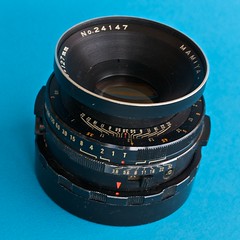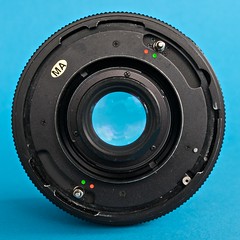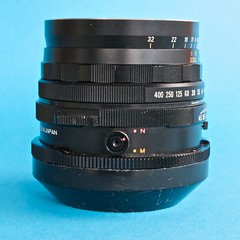Mamiya RB67
The RB67 is a series of 6 × 7 professional medium format SLR camera system by Mamiya.

|
| Anatomy of an RB67 Pro image by Raphael Borges (Image rights) |
Contents
RB67 Professional
The first camera released was the RB67 Professional in 1970. The system comprise of a camera body, viewfinder, back adapter, film back, and lens. The camera body itself is quite simple and fully mechanical. It does not require any battery power. The shutter button is located on the front bottom right of the camera. It can be locked with a twist of the collar. The shutter is cocked manually by pressing down the large lever on the right hand side of the body. The mirror within the camera and shutter in the lens are cocked at the same time. There are two focusing knobs on each side of the camera body similar to the Mamiya C series TLRs. The focusing screens are also interchangeable. The most common back adapter included in the system is the rotating back. The naming of the camera RB67 stood for Rotating Back 6 × 7.
The RB67 was originally designed to supplement the Mamiya C series 6 × 6 TLR system and the multi-format Mamiya Press rangefinder camera system (6 × 4.5, 6 × 7, 6 × 9, others) but has surpassed them in popularity. Back adapters for using Mamiya Press roll film and instant film backs are also available. Due to its heavy weight (almost 2kg for the body alone) the RB67 is often said to be unsuitable for use hand-held use. This isn't necessarily true - with a decent neck strap the RB67 can easily be used on the move. The flexibility of the RB67 system made it one of the most popular studio cameras in the 1970s.
Lenses
It takes lenses with the RB mount which is a bayonet type system with a locking ring. Lenses are equipped with Seiko leaf shutters and focus is set on the camera body using a bellows arrangement with a 46mm extension. The click stops can be at half-stop aperture settings, but the shutter speeds can only be set at full stops. A depth of field preview lever is also built-in to the lens. The lenses typically have shutter speeds of 1 to 1/400 of a sec. and a T mode. The T mode, keeps the lens shutter open until the shutter ring is moved onto the 1 sec mark or when the shutter cocking lever is pressed slightly. Since it's a leaf shutter based camera, electronic flash sync is available at all speeds. Since the system is synchronized, the camera body and lens must be cocked before attaching or removing the lens. To cock the lens ensure that the pins are inline with the red indicators. A majority of the lenses use a screw on 77mm filter making it much easier to swap filters between lenses.
|
|
|
Backs
The 6 × 7 format was chosen as it enlarges well to 8 × 10. The backs are designed similar to a Graflok style back, other manufacturers that have the Graflok fitting may be used. The rotating back adapter made it much easier to switch from portrait format to landscape format without having to re orientate the camera. It was most common for the system to use 120 or 220 roll film backs for 10/20 exposures. A 6 × 4.5 back was also produced. The roll film back would attach to the rotating adapter which connect to the camera body. The roll film backs used a single stroke film advance, with an automatic resetting exposure counter. The dark slide system allows the film backs to be exchanged without losing an exposure. As a safety measure the shutter does not fire if the dark slide is not fully removed. Pulling it out slightly will enable firing of the shutter. The film back can only be removed with a dark slide inserted. The revolving adapter also needs to be turned fully to the stop position before the shutter can fire.
Mamiya backs from the Press system are compatible with the RB67 with the use of the P-adapter. The P-adapter converts the RB67 back into a Press back similar to the one on the Mamiya Press Universal camera system.
Use of Polaroid instant film is also supported. Mamiya did not originally have a dedicated Polaroid packfilm back designed for the RB67. It required the use of a separate P-adapter to mount the instant back that was designed for the Mamiya Press. Later, dedicated RB67 Polaroid backs were introduced that mounted directly to the RB67 instead of through a P-adapter.
General usage
For a basic system with a waist level finder, revolving adapter, roll film back and lens.
With roll film loaded and everything ready. First remove the dark slide between the film back and rotating adapter. There is an area on the left hand side of the body where it could be stored. Raise the waist level finder hood from the back and flipping forward. The viewfinder will be erect. To raise the magnifier, slide the switch on the top panel of the hood to the right. The magnifier will pop-up. Press it down if you wish to retract it. Determine and set exposure settings on the lens along with focus on the camera body. The shutter is cocked manually by pressing down and forward on a lever at the right hand side of the body. Fire the shutter. The exposure indicator on the roll back turns red. Advance the film with the lever on the film back. The exposure indicator turns white. For double exposure, do not wind the film back. To close the finder, collapse the left and right sides first followed by the back and front panels.
For mirror lockup photography a shutter release cable is recommended. Connect it to the lens by screwing it on. Change the knob setting on the lens from N to M by pulling out and rotating. Set and compose the shot. Release the shutter button on the body. The mirror will flip up, but the lens shutter will not fire. Press the cable release, the lens shutter will now release. The next exposures will remain in mirror lock mode unless changed. Return the lens knob to N for normal exposures.
RB67 Pro-S
The RB67 Pro-S or Professional S as written on the body, was released in 1974, and is the most common RB67 camera. It was sold for over 15 years. It improved upon the previous model by having an orientation indicator for portrait or landscape mode on the rotating back. This was a feature on the original, but a majority of them did not include the printing.
The focusing has been changed a bit with a new focusing knob lock. It is located below the left hand side focus knob. To use it move the lever forward towards the front of the camera.
The shutter interlock system has also been revised slightly. On the Pro-S roll back the shutter cannot be released if the film is not advanced. That means the the previous method of multiple exposure is changed. The film back now contains an additional multiple exposure lever, under the film advance lever. To use; rotate the lever to the front revealing the red indicator. Cover the red indicator to revert to normal.
The waist level finder had been changed a bit. The magnifier can be raised by moving a small lever on the inside top of the front finder. The magnifier now completely covers the opening of the finder. This reduces the amount of exterior light that enters the focusing screen. Closing the finder is much easier and requiring only pinching the sides to collapse. The original requires you to collapse all four sides independently.
A special limited edition called RB67 Professional GL was also released in 1981. It does not state GL on the body and is identical in specifications to the Pro-S, but uses gold colour instead of chrome colour metal. It is also wrapped in a different reddish brown coloured leather.
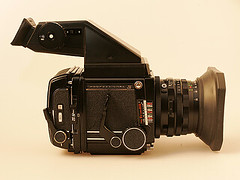
|
| RB67 Pro S with PD prism image by Siim Vahur (Image rights) |
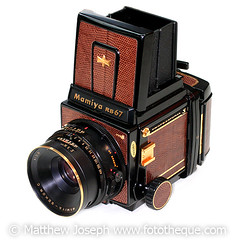
|
| RB67 GL image by Matthew Joseph (Image rights) |
RB67 Pro-SD

|
| RB67 Professional SD image by John Gateley (Image rights) |
The RB67 Pro-SD or Professional SD as written on the body was released in 1990. It supports L series lenses along with 6×8 backs. These lenses require a slightly larger lens mount diameter, it is now 61mm instead of 54mm. Because the mount is a larger size an adapter is necessary in order to mount original and C lenses. K/L and L lenses do not require an adapter. The focusing distance scale has been changed and now has an additional listing for a 140mm lens. The Pro-SD roll film back is nearly the same functions as the Pro-S back, but the dark slide can be inserted on the left or right side of the back.
System
Lens
Original
The original lenses were released along with the RB67 Pro in 1970. They only have a single anti-reflective coating. Requires an adapter to mount to RB67 Pro-SD cameras.
C
The C lenses were released with the RB67 Pro-S in 1974. These lenses are multi-coated. Requires an adapter to mount to RB67 Pro-SD cameras.
K/L
The K/L lenses are a slightly newer design with better coatings than the C lenses. The K/L is a code to indicate which bodies the lenses are compatible with. K indicates the Pro/Pro-S bodies and L indicates the Pro-SD bodies. These lenses mount directly to RB67 Pro-SD cameras without an adapter. Mounting on RB67 and RB67 Pro-S cameras require removing a ring adapter from the back of the lens.
L
The L lenses are compatible with the Pro-SD only, due to the fact they need a larger "throat" to mount on the camera. The only L lenses are the 75mm Shift lens and 500mm APO lens.
|
Zoom
|
|
Lens accessory
Focusing screens
Finder
|
Body
Film backs
|
Adapters
Instant
Mamiya Press backs
|
| RB67 Pro | RB67 Pro-S | RB67 Pro-SD | |
|---|---|---|---|
| Introduction | 1970 | 1974 | 1990 |
| Orientation indicator | X | O | |
| Focus lock | X | O | |
| L lenses | X | O | |
Bibliography
- Kamera no ayumi. Zen nihon shashin renmei sōritsu 50-shūnen kinen (カメラのあゆみ・全日本写真連盟創立五〇周年記念, History of cameras, commemorating the 50th anniversary of the All Japan Association of Photographic Societies). Tokyo: Asahi Shinbunsha, 1976. No ISBN number. P.107.
- Lewis, Gordon, ed. The History of the Japanese Camera. Rochester, N.Y.: George Eastman House, International Museum of Photography & Film, 1991. ISBN 0-935398-17-1 (paper), 0-935398-16-3 (hard). Pp.133 and 169.
- McKeown, James M. and Joan C. McKeown's Price Guide to Antique and Classic Cameras, 12th Edition, 2005-2006. USA, Centennial Photo Service, 2004. ISBN 0-931838-40-1 (hardcover). ISBN 0-931838-41-X (softcover). P.648.
- Sugiyama, Kōichi (杉山浩一); Naoi, Hiroaki (直井浩明); Bullock, John R. The Collector's Guide to Japanese Cameras. 国産カメラ図鑑 (Kokusan kamera zukan). Tokyo: Asahi Sonorama, 1985. ISBN 4-257-03187-5. Item 2171.
Links
In English:
- Mamiya RB67 at photoethnography.com by Karen Nakamura
- Mamiya Cameras Instruction Manuals - English at Mike Butkus' Orphan Cameras
- Mamiya RB67 Guide
- RB67 notes and old bulletin-board discussions at Robert Monaghan's Medium format Phtography website (medfmt.8k.com - archive copy dated 8 May 2006, at the Internet Archive)
In French:
- RB67 Pro S on www.collection-appareils.fr by Sylvain Halgand

